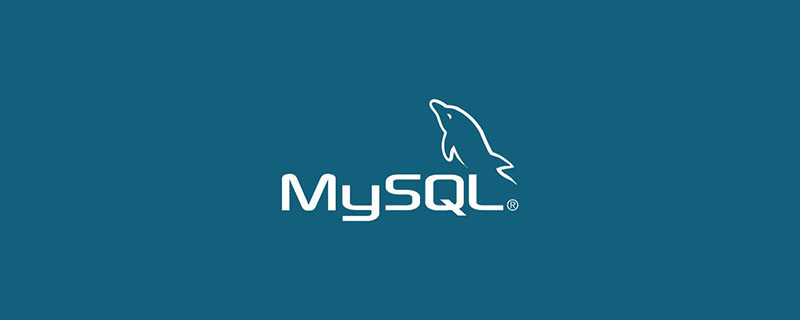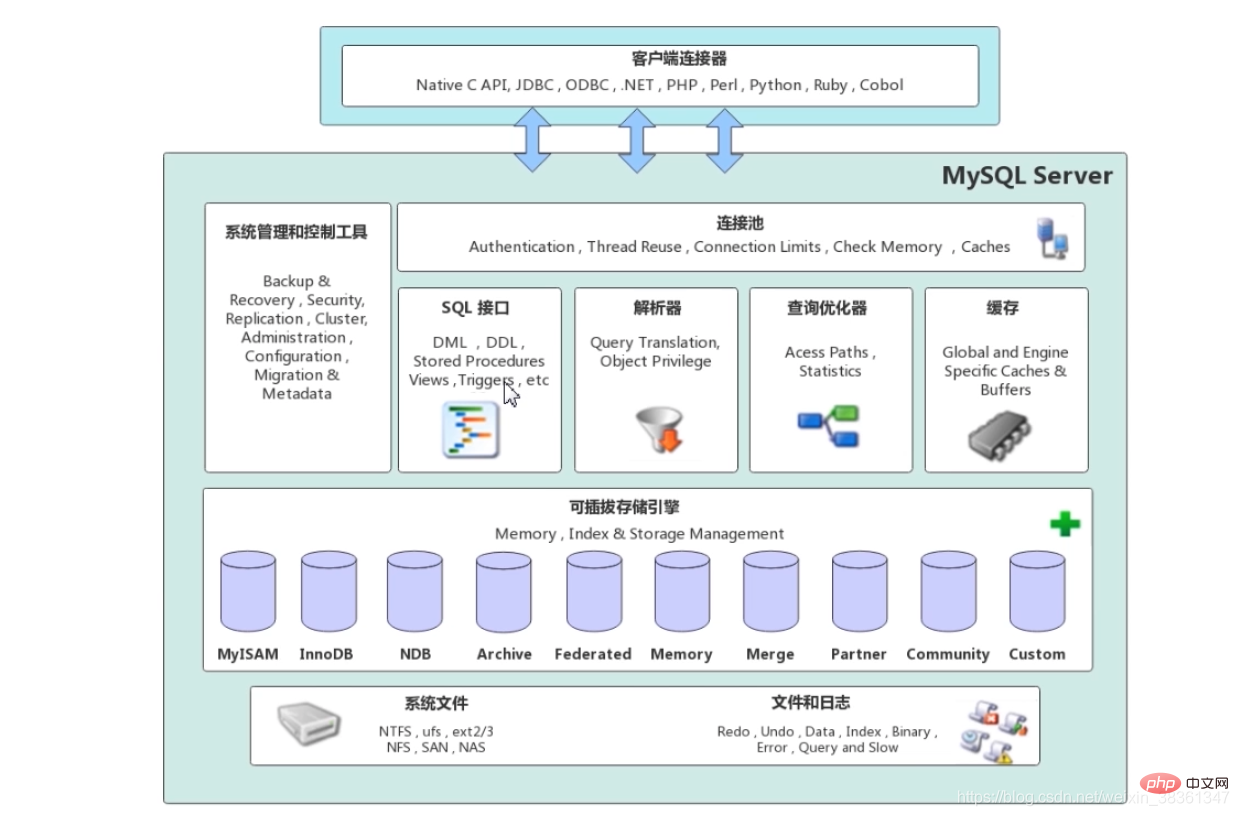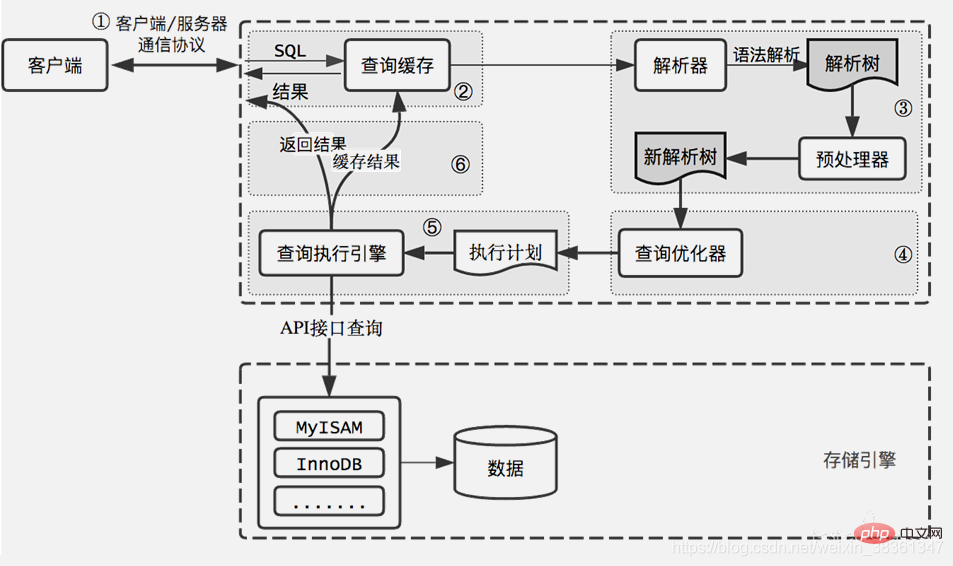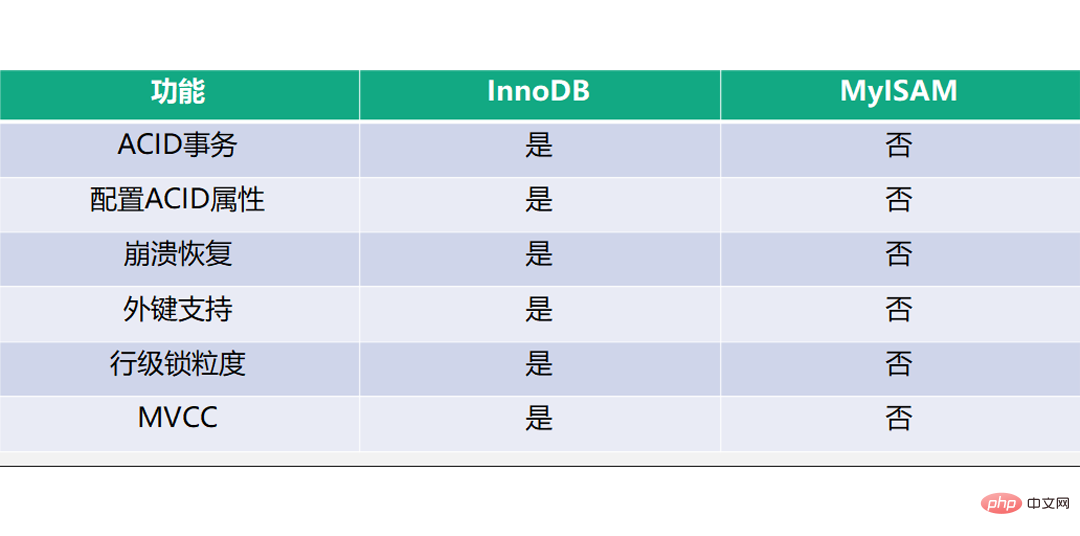Understand MySQL architecture
mysql video tutorial Column introduces MySQL system architecture

Recommended (free): mysql video tutorial
MySQL architecture
MySQL architecture is mainly divided into two parts: Client and server

Client
The client connector is mainly responsible for the connection of some clients, targeting different programming languages The driver provides connection services.
Server
The service layer includes: system management and control tools, connection pool, SQL interface, parser, query optimizer, cache.
Connection pool
Responsible for managing the connection between the client and the service layer data processing, and verifying the user's permission to perform operations.System management and control tools
Responsible for backup security, security management, cluster management services and tools, etc.SQL interface
Receives client sql commands and returns the results required by the user. Such as: dml, ddl, stored procedures, views, triggers and other commands.Parser
Word (keyword) analysis, syntax analysis, receiving sql, parsing it, generating a parse tree, and syntax verification check.Query optimizer: After generating the parse tree and passing the parser grammar, the optimizer selects an appropriate index, then generates an execution plan, and then interacts with the execution engine.
Caching
The caching mechanism is composed of a series of caches.
Such as: table cache, record cache (sql query results are cached, and the same sql query will be returned from the cache next time),
permission cache, engine cache, etc. If the cache hits, the data will be fetched directly from the cache.Storage engine layer
Responsible for reading and accessing Mysql data, such as InnoDB, MyISAM, etc. Pluggable, different storage engines can be replaced.System file layer
Such as logs, data files, etc.
A SQL execution process

- First the client connects;
- Secondly, verify user permissions and other operations in the connection manager of the server layer;
- Then if it is a non-8.0 version, it will check the current sql cache in the cache pool, and return directly if there is any;
- If it is not in the cache, a parse tree will be generated by the parser syntax and semantics;
- The optimizer parses to generate an execution plan and selects the appropriate index;
- The storage engine calls the API interface to query data, update the cache cache with the queried data;
- Finally return it to the client;
Storage engine layer
The storage engine is The subsystem in MySQL that specifically deals with files is a system abstracted based on the file system for dealing with mysql and disk files;
Commonly used storage engines, MyISAM, InnoDB that supports transactions;
- Before version 5.6 of MySQL, the default storage engine was MyISAM;
- After version 5.6, the default storage engine was InnoDB;
Function comparison

InnoDB supports 4 transaction characteristics of ACID, but MyISAM does not support it;
InnoDB supports 4 transaction isolation levels, the default is repeatable Read Repeatable Read, MyISAM does not support it;
InnoDB supports crash safe recovery, MyISAM does not support it;
InnoDB supports foreign keys, MyISAM does not Support;
InnoDB supports row-level lock granularity, MyISAM does not support it, and only supports table-level lock granularity;
InnoDB supports MVCC, MyISAM is not supported;
The above is the detailed content of Understand MySQL architecture. For more information, please follow other related articles on the PHP Chinese website!

Hot AI Tools

Undresser.AI Undress
AI-powered app for creating realistic nude photos

AI Clothes Remover
Online AI tool for removing clothes from photos.

Undress AI Tool
Undress images for free

Clothoff.io
AI clothes remover

Video Face Swap
Swap faces in any video effortlessly with our completely free AI face swap tool!

Hot Article

Hot Tools

Notepad++7.3.1
Easy-to-use and free code editor

SublimeText3 Chinese version
Chinese version, very easy to use

Zend Studio 13.0.1
Powerful PHP integrated development environment

Dreamweaver CS6
Visual web development tools

SublimeText3 Mac version
God-level code editing software (SublimeText3)

Hot Topics
 1664
1664
 14
14
 1423
1423
 52
52
 1317
1317
 25
25
 1268
1268
 29
29
 1243
1243
 24
24
 MySQL's Role: Databases in Web Applications
Apr 17, 2025 am 12:23 AM
MySQL's Role: Databases in Web Applications
Apr 17, 2025 am 12:23 AM
The main role of MySQL in web applications is to store and manage data. 1.MySQL efficiently processes user information, product catalogs, transaction records and other data. 2. Through SQL query, developers can extract information from the database to generate dynamic content. 3.MySQL works based on the client-server model to ensure acceptable query speed.
 Laravel Introduction Example
Apr 18, 2025 pm 12:45 PM
Laravel Introduction Example
Apr 18, 2025 pm 12:45 PM
Laravel is a PHP framework for easy building of web applications. It provides a range of powerful features including: Installation: Install the Laravel CLI globally with Composer and create applications in the project directory. Routing: Define the relationship between the URL and the handler in routes/web.php. View: Create a view in resources/views to render the application's interface. Database Integration: Provides out-of-the-box integration with databases such as MySQL and uses migration to create and modify tables. Model and Controller: The model represents the database entity and the controller processes HTTP requests.
 MySQL and phpMyAdmin: Core Features and Functions
Apr 22, 2025 am 12:12 AM
MySQL and phpMyAdmin: Core Features and Functions
Apr 22, 2025 am 12:12 AM
MySQL and phpMyAdmin are powerful database management tools. 1) MySQL is used to create databases and tables, and to execute DML and SQL queries. 2) phpMyAdmin provides an intuitive interface for database management, table structure management, data operations and user permission management.
 MySQL vs. Other Programming Languages: A Comparison
Apr 19, 2025 am 12:22 AM
MySQL vs. Other Programming Languages: A Comparison
Apr 19, 2025 am 12:22 AM
Compared with other programming languages, MySQL is mainly used to store and manage data, while other languages such as Python, Java, and C are used for logical processing and application development. MySQL is known for its high performance, scalability and cross-platform support, suitable for data management needs, while other languages have advantages in their respective fields such as data analytics, enterprise applications, and system programming.
 Solve database connection problem: a practical case of using minii/db library
Apr 18, 2025 am 07:09 AM
Solve database connection problem: a practical case of using minii/db library
Apr 18, 2025 am 07:09 AM
I encountered a tricky problem when developing a small application: the need to quickly integrate a lightweight database operation library. After trying multiple libraries, I found that they either have too much functionality or are not very compatible. Eventually, I found minii/db, a simplified version based on Yii2 that solved my problem perfectly.
 Laravel framework installation method
Apr 18, 2025 pm 12:54 PM
Laravel framework installation method
Apr 18, 2025 pm 12:54 PM
Article summary: This article provides detailed step-by-step instructions to guide readers on how to easily install the Laravel framework. Laravel is a powerful PHP framework that speeds up the development process of web applications. This tutorial covers the installation process from system requirements to configuring databases and setting up routing. By following these steps, readers can quickly and efficiently lay a solid foundation for their Laravel project.
 MySQL for Beginners: Getting Started with Database Management
Apr 18, 2025 am 12:10 AM
MySQL for Beginners: Getting Started with Database Management
Apr 18, 2025 am 12:10 AM
The basic operations of MySQL include creating databases, tables, and using SQL to perform CRUD operations on data. 1. Create a database: CREATEDATABASEmy_first_db; 2. Create a table: CREATETABLEbooks(idINTAUTO_INCREMENTPRIMARYKEY, titleVARCHAR(100)NOTNULL, authorVARCHAR(100)NOTNULL, published_yearINT); 3. Insert data: INSERTINTObooks(title, author, published_year)VA
 Solve MySQL mode problem: The experience of using the TheliaMySQLModesChecker module
Apr 18, 2025 am 08:42 AM
Solve MySQL mode problem: The experience of using the TheliaMySQLModesChecker module
Apr 18, 2025 am 08:42 AM
When developing an e-commerce website using Thelia, I encountered a tricky problem: MySQL mode is not set properly, causing some features to not function properly. After some exploration, I found a module called TheliaMySQLModesChecker, which is able to automatically fix the MySQL pattern required by Thelia, completely solving my troubles.




